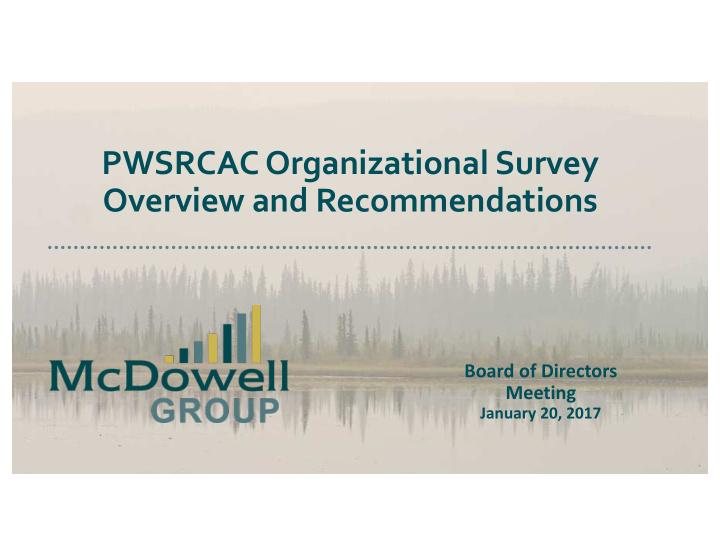



PWSRCAC Organizational Survey Overview and Recommendations Board of Directors Meeting January 20, 2017
McDowell Group Multidisciplinary research and consulting since 1972 17 professional staff; offices in Juneau, Anchorage, Bellingham 100 projects each year for government, for-profit, and nonprofit organizations Program planning and evaluation; survey and executive interview research; economic and policy analysis, service needs assessment, and financial feasibility
Topics for Today Study Purpose and Method Findings and Recommendations
Purpose and Method
Purpose of the Survey Wide-ranging self-reflection Broad participation (56 responses) 15 board 25 committee volunteers 16 staff Organizational improvement Structure Processes
Questions to Address Quality of the day-to-day work environment Committee structure, focus and inter-relationships Organization, participation level, and effectiveness of board meetings Appropriateness and effectiveness of decision-making processes Organizational structure, processes and strategic direction Interaction between paid staff and volunteers and implications for staff support and volunteer commitment, involvement, and effectiveness Self-monitoring and ongoing organizational improvement Communications at all levels
Survey Method Interviews with staff, board, volunteers to help identify issues and design and refine questions Online programming and fielding Preliminary analysis –Volunteers Workshop Written report Board of Directors Meeting – findings and recommendations
Findings and Recommendations
Major Themes Positive responses overall Technical committees viewed as highly effective but potential to be more efficient and strategically driven Not a board-driven organization Staff most interested in change Technical committees influential
Challenges What are the two biggest challenges you face in the work you do at PWSRCAC?
Comments & Suggestions What other comments or suggestions do you have to make PWSRCAC as effective as possible?
Areas of Potential Improvement Effective meetings Time management Communications Planning, prioritizing and evaluating Recruiting, supporting, facilitating the board of directors
Suggestions for Action Upgrade teleconferencing technology and include video-conferencing Consider additional technical committee work sessions Look for small improvements in meeting process/facilitation Develop or update board and committee charters: duties, goals, expectations Establish a board self-assessment process
Suggestions for Further Discussion Re-assess information flow to and from communities – who, what, when, how Explore ways to be more strategic about planning, prioritizing, and evaluating Re-visit strategic planning process with the goal of clearer ties between mission/OPA 90/Alyeska contract and annual project/program priorities Identify measurable intermediate variables Emphasize data-driven evaluation Form an ad hoc committee to review technical committee structure
The Mission “Citizens promoting the environmentally safe operation of the Alyeska terminal and associated tankers.” How does PWSRCAC determine the extent to which projects and programs advance this mission?
Committee Structure General, but not overwhelming sense committee structure could be improved Strongest for staff (6.1) Weakest for board (3.8) Two-thirds think PWSRCAC has the right number of committees
Committee Structure One-third suggested new combinations, especially: Combine POVTS and TOEM Combine Environmental Monitoring and SAC Combine POVTS and OSPR Lack of clear consensus warrants discussion
Biggest Complex Need? A more strategic long-term plan with specific intermediary goals Link projects clearly to mission-driven priorities Help focus and expedite project selection process Clarify what expertise and committee structures are needed Support evaluation of impacts
THANK YOU! Scott Miller – scott.miller@mcdowellgroup.net Lauren Rocco – lauren.rocco@mcdowellgroup.net
Recommend
More recommend